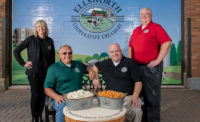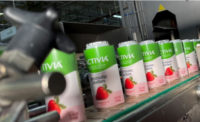The small town of Ellsworth, Wis., which is tucked into the Northwest corner of Wisconsin close to the Twin Cities, has a big claim to fame. In a state renowned for its cheese curds, it was the town designated the “Cheese Curd Capital of Wisconsin” due to being home to the eponymous Ellsworth Cooperative Creamery.
The cooperative has operated a plant in Ellsworth since 1910 (See the Processor Profile), but the facility’s cheesemaking operations began in the 1960s. In the 1980s, Ellsworth began expanding its cheese curd production beyond just local sales. According to Kari Skibbie, senior director of sales and marketing, the company now manufactures 180 SKUs in Ellsworth. (It also operates plants in Comstock, Wis., and New London, Wis.).
In essence, the Ellsworth plant is a white cheddar barrel cheese plant, Paul Bauer, CEO, notes. The cooperative also dries its own whey there. The plant has 100,000 square feet of production space; it additionally has a packaging wing, where it packages curds and also does some cut and wrap for the cooperative’s other plants. The Ellsworth location contains the main office of the cooperative, along with a retail store where it sells cheese curds to the local region.
It starts with local milk
Curd production at the Ellsworth plant begins every morning at 3:30 a.m., when tankers deliver milk from local farms that belong to the cooperative, says John Freyholtz, director of operations. The farms are all located within a 120-mile radius of the facility.
The plant team has learned it takes “exactly 21 minutes” to unload a tanker of milk and send it on its way, Bauer explains.
“Haulers were always complaining about if they pumped against an empty silo, they could unload in 14 minutes. And if they pumped against a full silo, it took 30 minutes,” he says. “So we put in a system that [uses] a collecting pump and then pumps it to the silo. So every tank gets unloaded in 21 minutes.”
According to Freyholtz, the milk in tankers is tested for antibiotics even before it is unloaded to make sure that it is safe to move into the plant. After leaving the receiving area, the milk goes through pasteurization. The facility is able to pasteurize 80,000 pounds of milk per hour.
“From there, [the milk will] go through the vats, and we'll add the starter, add the rennet,” Freyholtz says. “It'll sit in the vats for about three hours. We'll pump it onto a draining table, where it'll knit together to make a big, probably 12- by 40-foot, sheet of cheese, and then we'll dice it down into the curds.”
Freyholtz says the curds are diced into about 3/4-inch by 3- to 4-inch strips. Then they are blown into the next piece of equipment, which is a salter. Here, the whey is drained off the curds so it can be sold separately. The curds are put into 500-pound barrels that travel to the New London plant for further processing, placed into 40-pound boxes for foodservice customers, or put into 1,000-pound totes to be transported to the packaging department.
“I kind of joke [that] the 1,000-pound unit is a large family-size container,” Bauer says.
Once the totes reach the packaging lines, the curds are put into different-sized containers for retail or for other foodservice customers.
“We used to package them by hand, but about six years ago, we had sufficient volume that we were able to put in a Yamato scale and a Matrix packaging unit,” says Bauer. “So we run them through [that equipment], and we can get somewhere between six to 40 units a minute.”
All told, the Ellsworth plant makes between 60,000 and 100,000 pounds of cheese curds a day, and that doesn’t count the cheese that goes into barrels for further processing, says Bauer.
Lots of plant upgrades
Since the Ellsworth plant is an older facility, the cooperative often needs to make upgrades to keep it up to date, especially since the amount of cheese curds it produces keeps expanding.
“When I started here in 2008, probably 2% of our volume was cheese curds, and that was hand-packed. That has rapidly grown to over 30%, depending on how much cheese we make for the year,” Bauer notes. “Our goal is to make more value out of [the milk]. And that takes more headcount and more equipment and more space and more warehousing, and it just keeps going.”
Freyholtz says the overall production has expanded a lot since he began working for Ellsworth.
“When I started 20 years ago, we were processing about 700,000 pounds of milk a day,” he explains. “On an average day now, we're gonna process about 1.7 million pounds of milk … in Ellsworth.”
According to Freyholtz, with this growth, the cooperative prioritizes becoming more efficient and controlling things in a better manner when it plans for upgrades.
“Basically, every time we do an upgrade to the plant, we try to add the best technology that's available to us to either lower the usage of water, gas or electricity, so we can get the product made more efficiently and effectively,” adds Bauer.
The most recent upgrades involved adding a cheese packaging building in 2016; a new office, whey dryer and store upgrade in 2013; and a cheese cooler in 2010, notes Bauer. The new cooler tripled the plant’s storage space, and it uses one-third less energy than the previous cooler.
And Freyholtz says that between 2008 and 2012, the cooperative added new membrane systems and upgraded some existing equipment such as pumps, motors and valves. Around the same time, it purchased an ultrafiltration system that helped expand its production by 20%.
Ellsworth also recently added a new engine room with a glycol plate chiller, Bauer says.
“From a safety standpoint, we've tried to remove as much ammonia exposure [as possible] in the plant,” he notes. “So we'll run our ammonia lines on the outside of the plant, or actually, they go into the glycol [plate chiller] instead.”
Ellsworth’s biggest planned capital expenditure for the future is actually building an entirely new plant in Menomonie, Wis., Bauer notes. The facility will expand the cooperative’s artisan cheese offerings, which currently are produced at the Comstock plant. The company eventually will repurpose the Comstock location for another type of production.
“Our focus has been to get as much value as we can for our members' milk,” Bauer says. “And so that requires adding some plants and diversifying our portfolio.”
Efficient sanitation cycles
To keep its operations efficient, Ellsworth uses a sanitation cycle that travels through the production process as pieces of equipment shut down for the night.
“So it starts with intake, goes to pasteurizer, goes to the vats, goes to the barrel room. Those areas get cleaned as you shut down,” says Freyholtz. “So by the time we start washing our last piece of equipment, we already have milk flowing to the vats again. It's truly about a five-hour window where we don't have milk flowing in the plant to make sure that we have enough time for sanitation.”
When milk starts coming into the plant at 3:30 a.m., there are still two pieces of equipment left to be cleaned. But since it takes time for the vats to be filled and to process the cheese, the sanitation process is complete by the time that equipment is needed again.
“So [the sanitation team] gets done washing, they do their final rinses, and 10 minutes later, there's cheese into that piece of equipment,” notes Freyholtz.
To ensure cleaning has been done effectively, Freyholtz says Ellsworth does titrations on chemicals to make sure they’re the right strength, checks charts to ensure the temperatures are right, and does ATP swabs.
A robust food safety process
In terms of food safety, Bauer says all of Ellsworth’s plants are either SQF or BRC certified. And the cooperative also has certifications from state milk shippers, USDA, the state of Wisconsin and FDA, along with a Chinese certification called AMS. With so many certifications to manage, Ellsworth has a dedicated staff person just to manage audits.
“You could say, on average, you probably have some sort of inspector here probably every two months going through records and/or equipment,” adds Freyholtz.
The cooperative takes a number of steps before releasing any products from its plant.
“We're pulling samples from every vat on milk; we're pulling samples of cheese that go through the lab for microbial and pathogen testing,” says Freyholtz.
Samples are also taken throughout production to check for pH and moisture levels and fat and salt content. Any samples have to be approved by the lab before the products can be released to the customer, Freyholtz adds. Ellsworth operates an in-house lab for microbial testing of its products at the Ellsworth facility, but sends out environmental samples for pathogen testing to a third-party lab. It takes 48 hours to verify all the test results and release a product.
Adapting to the pandemic
In normal times, the Ellsworth facility produces more cheese curds for foodservice than for retail. But during the current coronavirus pandemic, the cooperative has had to adapt to ensure it wouldn’t have to dump large quantities of milk, says Bauer.
“Where we were 60% foodservice before and 40% retail, that's probably flipped here during COVID because all the restaurants were closed down, and our retail just took off,” says Skibbie. “People who were only foodservice, you know, what happened? They just lost orders. But the fact that we were set up for retail and already doing retail meant we could pivot very fast.”
According to Bauer, one of the biggest challenges with the pandemic has been its unpredictability.
“COVID is really playing havoc with numbers and trying to project things,” he says. “We had to pivot 100 semi-loads of cheese in that critical six-week period of foodservice just not being there to take product. So we put it in an inventory for long-term storage.”
In the early days of the pandemic, Ellsworth also had difficulty with the unavailability of supplies it needed, including packaging materials and cheesemaking ingredients. It often had to adapt to using alternative packaging.
“We always carry some plain film. So in some applications where we probably would have wanted to use printed film, we went to plain film instead. But there's only a few customers you can do that to,” says Bauer. “And then some customers were awesome to say, ‘Make whatever you can and we'll take it.’”
Now, Freyholtz says, the cooperative orders large quantities of supplies far in advance to ensure it has enough to last for long stretches of time.
“COVID certainly has been challenging in that, as an industry, we had some excess [milk] volume … and that put strain on our cooperative in order to handle that excess volume, as some of the contracts that we had secured were not being honored by fellow cooperatives,” Bauer explains. “And we're able to manage through that. We did some creative things with our membership in order to reduce our volume slightly.”








